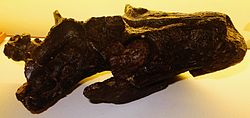Whaitsia
|
Theriognathus Temporal range: Wuchiapingian, 260.4–253.8 Ma |
|
|---|---|
 |
|
| T. microps Fossil | |
| Scientific classification | |
| Kingdom: | Animalia |
| Phylum: | Chordata |
| Class: | Synapsida |
| Order: | Therapsida |
| Suborder: | Therocephalia |
| Family: | Whaitsiidae |
| Genus: |
Theriognathus Owen, 1876 |
| Species | |
|
|
| Synonyms | |
|
|
Theriognathus (from Greek therion: beast, mammal, Greek, gnathos, “jaw,” +us, pronounced THEH-ree-OG-nah-thuss) is an extinct genus of therocephalian therapsid belonging to the family Whaitsiidae, from South Africa and Tanzania. Theriognathus has been dated as existing during the Late Permian. Although Theriognathus means mammal jaw, the lower jaw is actually made up of several bones as seen in modern reptiles, in contrast to mammals. Theriognathus displayed many different reptilian and mammalian characteristics. For example, Theriognathus had canine teeth like mammals, and a secondary palate, multiple bones in the mandible, and a typical reptilian jaw joint, all characteristics of reptiles. It is speculated that Theriognathus was either carnivorous or omnivorous based on its teeth, and was suited to hunting small prey in undergrowth. This synapsid adopted a sleek profile of a mammalian predator, with a narrow snout and around 1 meter long. Theriognathus is represented by 56 specimens in the fossil record.
Theriognathus is represented by abundant occurrences in the Karoo Basin of South Africa, sequestered records in the Upper Permian Ruhuhu Basin of Tanzania, Zambia, and Russia. Late Permian therapsids are best known from the Karoo Basin, which covers a massive area and provides Permian sediments that total 12 km in thickness. During the Late Permian, sediments were fed into the Karoo Basin from a ring of mountains that encircled Southern Gondwana (an ancient supercontinent, partly located on what is now South America and Antarctica) In the Karoo is the Beaufort Group, a subdivision of the basin. This division is further broken down into assemblage zones, intervals of geological strata that are defined based on the distributions of previously found tetrapod taxa.
Theriognathus has been found in the Wuchiapingian, upper Tropidostoma, Cistecephalus, and lower Dicynodon assemblage zones in the Upper Permian, Karoo Basin, South Africa; Wuchiapingian, Cistecephalus assemblage zones in the Upper Permian, Ruhuhu Basin, Tanzania; Wuchiapingian Cistecephalus assemblage zones in the Upper Permian, Luangwa Basin, Zambia; the Wuchiapingian, Upper Permian, Kotelnich, Kirov region, Russia;, the Changxingian Archosaurus assemblage zone, Upper Permian, Vladimir region, Russia.
...
Wikipedia
